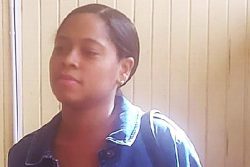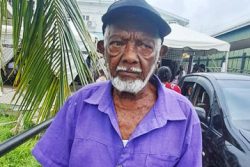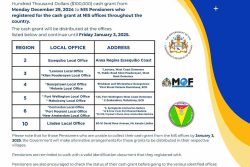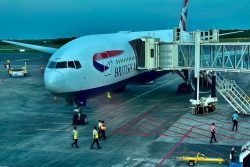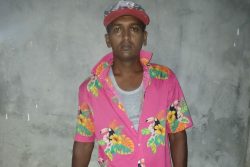Controversial Brazilian rice farmer Paulo Cesar Quartiero is among a group of 15 investors from the State of Roraima who have applied to the Guyana Lands and Surveys Commission for permission to lease 20,000 acres of land in Region Nine.
Victor Pires, Managing Director of Caribbean Chemicals and spokesperson for the Brazilian investors, last week said that the group had already submitted the relevant applications for leasing the land and other “details” in relation to the investment. The group, Pires said, was awaiting responses at this point.
The rice cultivated in Region Nine would not be sold on the local market but would be intended for export to Brazil. Pires added that the group would also cultivate soya which would eventually reach local coastal markets if or when access overland was available to these markets.
Quartiero was earlier quoted in the Brazilian media as saying the Government of Guyana would be leasing him land in the Rupununi for 99 years. Concerns had been raised about the report since Quartiero has been named in Brazilian and international media as allegedly leading violent resistance by rice farmers holding estates in an Amerindian reservation called Raposa Serra do Sol (located in the State of Roraima) to their eviction from there.
Responding to Quartiero’s statement, Minister of Agriculture Robert Persaud confirmed last month that a group of investors from the State of Roraima had visited Guyana recently, to explore the availability of land for rice cultivation in Region Nine. The government, Persaud said, was willing to consider an acceptable investment proposal for rice and soya cultivation in the region and specific areas for cultivation had been identified by the investors. The minister gave the assurance that no consideration would be given to land demarcated or to be demarcated for Amerindian communities. The availability of land areas, he said, was under review by the Guyana Lands and Surveys Commission.
Nothing to fear
Stabroek News had previously reported on the possible leasing of the land as well as reports of Quartiero’s alleged poor environmental record and his role in the violent resistance to moving out of Amerindian lands in Raposa Serra do Sol.
Pires last week described the Stabroek News articles as being “one sided”. The farms in question, Pires said, had been privately owned for about 100 years. According to him, over 400 privately owned farmers’ lands had been taken by the Brazilian government to add to Amerindian lands.
Guyanese, Pires said on behalf of the investors, had nothing to fear. The farmers evicted form Raposa Serra do Sol never “stated that they would arm themselves to fight the land seizure by the government,” but only asked to be fairly treated and paid for the years of work they had put into their farms. “Guyana has the choice to develop a small part of Region Nine, less than five per cent, to feed 20 million Brazilians from Manaus to B Fim with rice, watermelons and other crops,” Pires said, adding, “I have worked with many of the 400 farmers involved over the last twenty years and they are all law abiding.”
Pires also expressed the view that the investment would increase employment in Region Nine, an area which he said had a high unemployment rate. There would be no heavy impact on the environment from the chemicals used in the farming process, he said, although when asked about the basis for making such a statement, he did not respond.
Guyana, according to the Guyana Office for Investment (Go-Invest) website, offers foreign investors the flexibility and advantage (as the particular situation may warrant) to purchase or lease land. Foreigners are treated in the same way as domestic investors for the purposes of acquiring or leasing property. Investors are offered a 99-year lease agreement which requires the investor to pay an annual rent of $1 or US$.005 per square foot with concessions being granted on building materials, vehicles, plant and machinery. The investor is responsible for reimbursing 25 per cent of the costs of basic infrastructure, currently ranging between $153 (US$0.76) to $210 (US$1.06) per square foot.
On March 19, in a 10-1 vote, a Brazilian tribunal reaffirmed the borders of the Raposa Serra do Sol reserve located in the State of Roraima, and ordered the expulsion of a group of rice farmers. A March 20, 2009 Sydney Morning Herald article said the Brazilian farmers had vowed to fight any attempt to force them out, and several stockpiled arms and threatened to blow up bridges and spike roads if police moved in.
‘Violent
involvement’
Pires denied allegations made about Quartiero’s “violent involvement” in the Raposa Serra do Sol resistance. Despite being informed of several articles in the Brazilian and international media, as well as reports from human rights and environmental organizations, Pires insisted that Quartiero was “only the spokesperson” for the group of farmers evicted from the Indian reservation.
“These reports are far from being true,” Pires stated; “Mr Quartiero was the spokesperson of the 400 farmers for the legal case… his farm is in the middle of nowhere and he never attacked any villages or burnt bridges and blocked roads.”
Survival International, the Rainforest Foundation, the Social Justice Secretariat and the Indigenous Missionary Council (CIMI) have all reported on the Raposa Serra do Sol issue and named Quartiero as the leader of what they described as “violent” resistance.
In a Brazzil article captioned ‘Brazilian Agribusi-ness Boom’s Dark Side: Violence and Plunder in the Amazon,’ published on October 16, 2008 journalist Isabella Kenfield reported extensively on Quartiero’s involvement in the resistance.
Kenfield wrote: “Since it came to power in 2003, the Lula government has been embroiled in a conflict between six large-scale rice growers and 19,000 indigenous people over 4.2 million acres of Amazon grassland, forest and river called Raposa Serra do Sol, in the northernmost state of Roraima, on the border with Venezuela and Guyana. Raposa Serra do Sol was demarcated as a single, continuous indigenous reserve by the administration of Fernando Henrique Cardoso in 1998, and signed into law by President Lula in 2005. Since then, the rice growers, who arrived in the region in the early 1990s, have been required by law to leave their large, landed estates, and offered financial compensation to do so.”
Leading the struggle to change the demarcation was Quartiero, the Brazzil article said. It described Quartiero as the largest rice farmer in Roraima, former mayor of the town of Pacaraima (part of which lies in Raposa Serra do Sol), and President of the Association of Rice Producers of Roraima (ARPR), a powerful group of rice growers integrated into national agribusiness markets.
Last March, Kenfield reported, when dozens of indigenous people began to non-violently agitate for full demarcation of Raposa Serra do Sol, the federal government ordered federal police to remove Quartiero and the other rice farmers, who thwarted the operation by blowing up bridges into the reserve. Quartiero, the article further said, organized a militia last May to attack the Indians with firearms and explosives, wounding ten people. The federal police later found 149 bombs on Quartiero’s farm that they suspect had been produced with the help of military personnel. Quartiero was briefly jailed.
While in prison, Quartiero was charged about US$16 million by the federal environmental agency (IBAMA) for the destruction of permanently protected land, impeding regeneration of grasslands, using state land without authorization, and undertaking agricultural activities in violation of his farming licence.
Pires, however, said that Guyanese had nothing to be worried about in terms of the group from the State of Roraima investing in Region Nine. This venture, he stated, would only benefit both countries.
